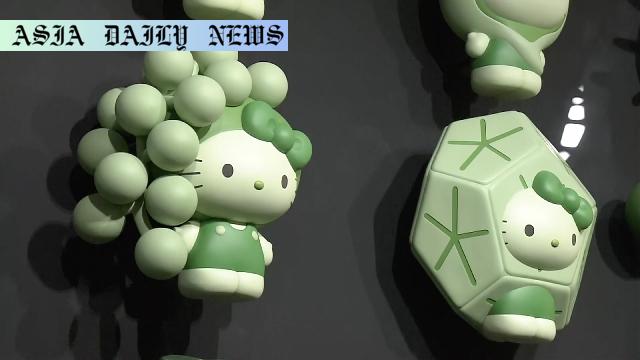Japan Pavilion leads the way for the 2025 Osaka World Expo, showcasing sustainable innovations and futuristic themes.
- Key Point 1: Japan Pavilion is the largest pavilion at the 2025 Osaka Expo with 13,000 square meters of floor space.
- Key Point 2: The pavilion focuses on sustainability using biogas electricity and algae-powered concepts.
- Key Point 3: Hello Kitty as a mascot promotes algae-like wakame and hijiki seaweed.
- Key Point 4: Interior furnishing work is scheduled to be completed by February 2025.

Overview of the 2025 Osaka World Expo
The 2025 World Expo in Osaka, scheduled to run from April 13 to October 13, will bring together 160 countries and territories under the theme, “Designing Future Society for Our Lives.” This significant event aims to serve as a platform for innovation, creativity, and sustainability on a global scale. One of the key attractions, the Japan Pavilion, stands out with its massive 13,000 square meter structure and its focus on advanced sustainability concepts.
The Japan Pavilion: A Blend of Tradition and Innovation
The Japan Pavilion operates as the host nation’s central hub and a guest house for foreign dignitaries attending the Expo. With its impressive two-story design, the pavilion embodies the theme of “Between Lives,” reflecting on ways to foster connections among different facets of humanity and the environment. The preview of the pavilion revealed an innovative approach featuring a facility near the entrance that uses microbes to decompose garbage collected at the venue.
Sustainability at the Forefront
One of the primary highlights of the Japan Pavilion is its commitment to sustainability. The microbe-driven waste decomposition system installed near the entrance produces biogas for electricity, powering the pavilion and setting an example for eco-friendly design. Such initiatives underscore Japan’s resolve to lead by example in promoting renewable energy and waste management solutions, especially in large-scale global events.
Innovative Mascot: Hello Kitty Embodies Algae
A creative twist draws attention to the themes of sustainability and addressing global challenges such as food shortages. The popular Japanese mascot, Hello Kitty, makes an appearance dressed as 32 types of algae, including wakame and hijiki seaweed. This unique representation symbolizes the potential of algae in becoming a viable source of fuel and food in the future. It adds a touch of cultural familiarity while aligning with the Expo’s futuristic vision.
The Role of Biogas and Algae in Shaping the Future
The Japan Pavilion’s focus on algae and biogas is not accidental. Algae, a renewable and easily cultivated resource, holds immense potential for addressing critical issues like energy and food security. The Expo’s emphasis on these initiatives offers insights into how science and technology can work together to design a better future for society.
Interior Completion and Future Prospects
While the pavilion is still under construction, the completion of interior furnishing is scheduled for the end of February 2025. Once fully operational, it will offer an immersive experience for visitors, combining cultural heritage with cutting-edge technology. The pavilion is poised to serve as a beacon of innovation, sustainability, and Japan’s dedication to finding solutions for global challenges.
Conclusion: A Visionary Effort by Japan
The Japan Pavilion at the 2025 Osaka Expo exemplifies forward-thinking on multiple levels. From its architectural grandeur to its sustainable practices and innovative exhibits, it encapsulates a vision for a society that prioritizes environmental stewardship, futuristic solutions, and global cooperation. Visitors to the pavilion are not just spectators but participants in shaping the future of society.



Commentary
Impressions on the Japan Pavilion
The Japan Pavilion for the 2025 Osaka World Expo is an extraordinary embodiment of innovation and sustainability. At a time when the world is grappling with environmental concerns and resource constraints, this pavilion showcases a forward-thinking approach to utilizing renewable resources like algae and biogas. It’s inspiring to see a host country not only lead in scale but also in addressing global challenges through creative and scientific means.
A Unique Blend of Culture and Modernity
What I find particularly impressive is the integration of cultural elements, such as the iconic Hello Kitty, with futuristic themes. Dressing Hello Kitty in algae outfits is a playful yet powerful statement, demonstrating that even beloved cultural icons can play a role in promoting sustainability. This balance of familiarity and innovation ensures the message resonates with a diverse audience.
Challenges and Future Impacts
Although the pavilion is still under construction, its potential to inspire and educate is evident. The focus on renewable energy and waste management practices is particularly crucial in today’s context. I hope this pavilion serves as a blueprint for future international events, showing how large-scale gatherings can prioritize environmental consciousness without compromising on creativity or impact.
Final Thoughts
The Japan Pavilion is more than just an architectural marvel; it is a call to action for sustainable living and innovative thinking. As someone deeply interested in global initiatives that support a better future, I cannot wait to see the completed structure and learn from its myriad exhibits. This pavilion is sure to leave an indelible mark, not just on the visitors but also on the broader conversation about sustainability worldwide.